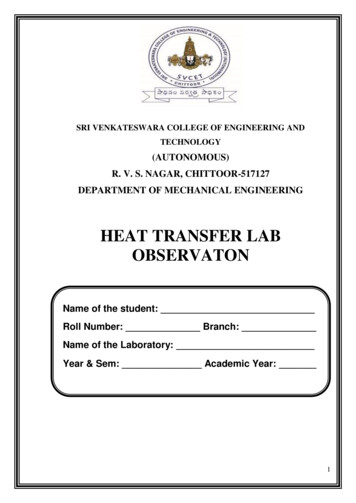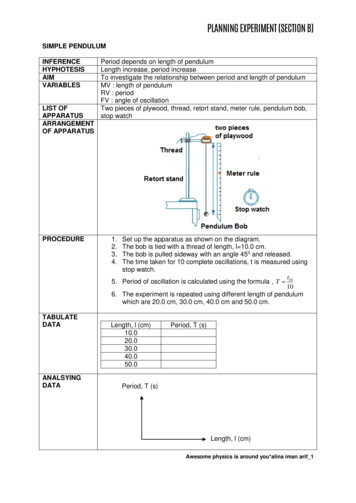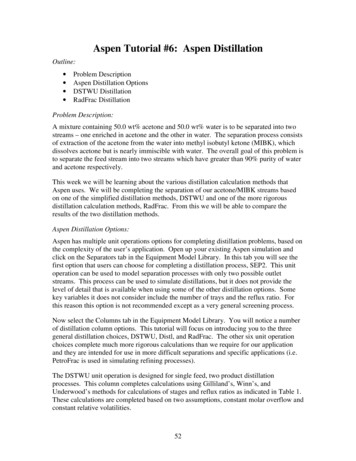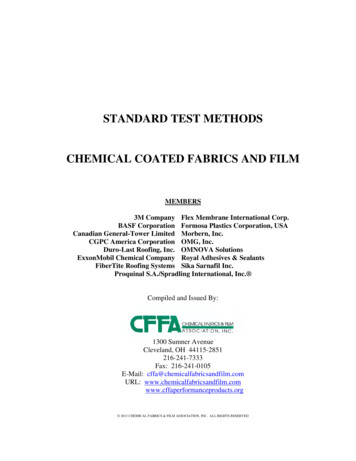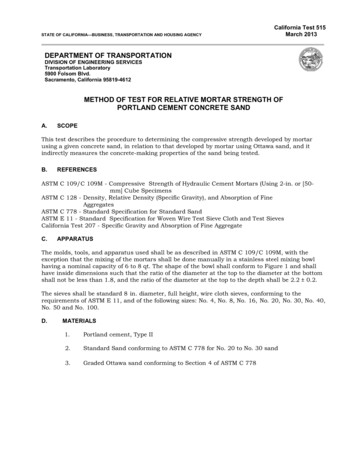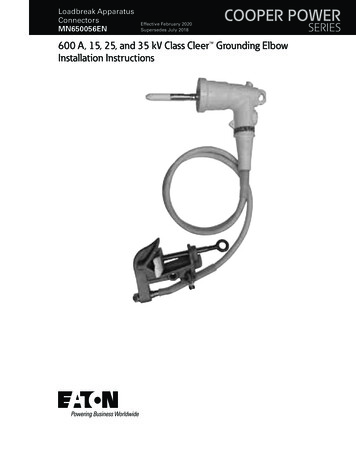
Transcription
B U I L D I N GAH O M ED I S T I L L A T I O NA P P A R A T U SA Step by Step GuideBuilding a HomeDistillationApparatusi
B U I L D I N GAH O M ED I S T I L L A T I O NA P P A R A T U SForewordThe pages that follow contain a step by step guide to building a relativelysophisticated still. It is directed at anyone who may want to know more about thesubject, for hobbyists, tinkers, pure water enthusiasts, survivors, and perhapsamateur wine and beer makers.The still involved in the chapters that follow is a unique distillation apparatus. Atthe time of this writing, there is only one like it. Designing and building thisapparatus is the only subject of this manual and you will find that it confines itselfto those areas. It does not enter into the domains of fermentation, recipes formaking mash, beer, wine or any other spirits. These areas are covered in detail inother readily available books and numerous web sites.My intent is to release this document into the public domain in such a manner thatanyone may freely copy, modify, or distribute its contents. Experience has shownthat ideas exchanged in this way can be refined into much better products whenany number of authors get involved and make their own contributions.However, the legal system being what it is, several issues can turn up in doingthis:1. Any free document containing patentable information such as this isthreatened constantly by second party patents. I want to avoid thedanger that re-distributors of this free document will individuallyobtain patent licenses, in effect making the document and it’s contentsproprietary. To prevent this, I’ve tried to make it clear that any patentarising from this document must be licensed for everyone's free use ornot licensed at all.2. Also, for each contributing author's protection and mine, I want tomake certain that everyone understands that there is no warranty forthe contents of this document. If the document is modified by someoneelse and passed on, its recipients must know that what they have is notthe original, so that any problems introduced by others will not reflecton the original authors' reputation.1
B U I L D I N GAH O M ED I S T I L L A T I O NA P P A R A T U STo avoid these problems I’ve copyrighted the document but basically givenanyone that wants to use, modify, or further distribute it, with or without fee, alicense to do that. The license is in Appendix A, and must be included, withoutchange, in any copies, modifications or distributions.You are not required to accept this License, since you have not signed it.However, nothing else grants you permission to modify or distribute thedocument or its derivative works. Law prohibits these actions if you do not acceptthis License. Therefore, by modifying or distributing the Document (or any workbased on the Document), you indicate your acceptance of this License to do so,and all its terms and conditions for copying, distributing or modifying theDocument or works based on it.So to put all these legal issues into practice, as you should do if you distribute it,here are the disclaimers:Building a Home Distillation Apparatus.Copyright (C) January, 1999 Small Still Engineering, LLCThis document is free; you can redistribute it and/or modify it under theterms of the License Agreement contained in Appendix 1.This document is distributed in the hope that it will be useful, butWITHOUT ANY WARRANTY; without even the implied warranty ofMERCHANTABILITY or FITNESS FOR A PARTICULAR PURPOSE.2
B U I L D I N GAH O M ED I S T I L L A T I O NA P P A R A T U STable of ContentsFOREWORD . 1INTRODUCTION. 1WHERE TO START?. 3WHAT KIND OF STILL? . 5CONSTRUCTION . 10BUILDING THE CONDENSER . 13BUILDING THE REFLUX COLUMN . 19HEATING CONSIDERATIONS. 25PUTTING IT ALL TOGETHER. 27APPENDICES . 2LICENSE AGREEMENT. 3HOW TO APPLY THE LICENSE AGREEMENT . 8MATERIAL LIST. 9TOOLS . 10INDEX . 113
B U I L D I N GAH O M ED I S T I L L A T I O NA P P A R A T U SChapterIntroduction1About Attitudes and RegulationSo you’re interested in building a still. In the US (and many othercountries) I guess you know that doing that is just not the politicallycorrect thing to do.Even if you are just a curious person and simply want to know what’sinvolved, you probably feel some reluctance about discussing the subjectoutside of your own trusted circles.The reason you feel this way, most likely, is because a lot of laws have beenpassed over time that severely restrict the ways that you may refine productscontaining ethyl alcohol.Most US residents are also quite familiar with the moonshine folklore, highpowered cars running shine over mountain back roads, and dodging the federalrevenue agents. So much so that many may feel that they are doing somethingimproper, or maybe even criminal by reading this.Everyone should follow his or her own conscience in these matters. Personally,I believe that some of these laws are so poorly thought out and implementedthat they border on being ridiculous.A case in point. In the US, the government allows an individual to producewine or beer for personal consumption by using a fermentation process toproduce an alcoholic beverage.The fermentation process however, produces a wine or beer containingchemicals that are actually poisonous for human consumption. Nevertheless,the government seems to think it is perfectly OK for an individual to fermentand drink the stuff, regardless of the impurities it may contain.1
B U I L D I N GAH O M ED I S T I L L A T I O NA P P A R A T U SUnbelievably, the US government also makes it illegal for an individual toremove the poisons from the alcohol in the wine or beer by distillation. Inother words, it is illegal for an individual to refine a legal beverage in theirown home and, in the process, produce another perfectly legal beverage fortheir own consumption! Figure that one out.Without much reflection, it is easy to see that such laws are flawed andwithout foundation in logic, justice, or the common good.Fortunately, it is not illegal to express these opinions. That freedom alsoextends to writing about such things as alcohol distillation (legal or not), andthe use and manufacture of equipment to effect this process in the home.So, as long as your conscience allows, at least in the US, you are not doinganything wrong by reading this information. There is also nothing illegalabout building a still.Having said that, recognize that the only purpose of this document is toeducate and inform those of you who are interested in this subject. It is not tobe construed in any fashion as an encouragement to break the law. If youbelieve the law is incorrect, please take the time to contact yourrepresentatives in government, cast your vote at the polls, write newsletters tothe media, and in general, try to make the changes in a legal and democraticmanner.And while it is hoped that the still will always be used for legitimate purposes, ifyou decide to distill ethyl alcohol then never forget that you are dealing with thelaw, and to twist an old barb:“If you can’t pay the bill then don’t use the still”Enough said. It’s time to get on with more practical things.2
B U I L D I N GAH O M ED I S T I L L A T I O NA P P A R A T U SChapter2Where To Start?Information SourcesIt doesn’t take long after making the decision to build a still to recognizethat there are a lot of things to be considered. A visit to the library, andsome reading about the distillation process is a good place to start.However living in a small rural town without a significant library can makethings more difficult. It’s even worse if the nearest big university is about 100miles away.If you find yourself in a similar condition you should consider starting with theInternet. Initial searches will turn up thousands of hits on the subjects ofmoonshining, distillation, stills, spirits, whiskey, reflux ratio, unit operationsetc.Unfortunately, there isn’t a whole lot of really good information about buildinga first class personal still out there. Sure, there are lots of commercialdistillers, beer and wine equipment suppliers, discussion groups, moonshiningstories, book sellers, discussion groups, and lots of chemistry information onthe web, but only a couple of quality publications on amateur distillation andstill construction. There are some good ones though.One of the first, and best, reference that I found was from a corporation inSweden run by Gert Strand. It was the “Home Distillation Handbook”,translated from Swedish to English and written under the pseudonym of OlaNorrman. It is available on line, for small fee in PDF format from//http:/partyman.sa.Partyman is a first class provider of liquor essences, fermentation, and fineGerman instrumentation equipment useful in alcoholic beveragemeasurements.3
B U I L D I N GAH O M ED I S T I L L A T I O NA P P A R A T U SOla Norrman’s book takes you step by step through every procedure involvedin the process of producing a variety of spirit drinks, including guidance in theconstruction of an appropriate still.Another good source can be found in Dr. John Stone’s book “Making Gin andVodka”. It can be ordered on http://www.gin-vodka.com. Dr. Stoneconcentrates on producing pure alcohol spirits (Vodka and Gin), but the bookdiscusses in detail the construction of a multi-stage distillation apparatus, muchlike a scaled down commercial facility might use. It is very complete indescribing every phase of producing and refining alcohol, and provides manyfirst hand insights into this process.For the more technically inclined, the web surfer should read M.T. Thams’Introduction to Distillation tutorial .For those of you who simply want a still, and not all the work of doing ityourself, you will enjoy the Still Life at http://stillife.com, and Ray Toms’Moonshine Supplies at http://moonshine.co.nz/ .The University at Akron offers an excellent slide presentation of distillationtheoryat: on/For the engineering students among us, you might find Andrew Sloleys’distillation and petroleum refining homepage a good start. You will find it at:http://asloley.home.mindspring.comAnd finally, for the best about the art, science, and folklore about distillingcheckout Bourbon Street /2588/distill.htmThese sites and books will give you a good starting background for thosethings you are about to undertake. Certainly there are many others that may beeven more appropriate. But for the most part, they provide an excellentfoundation for constructing a high quality apparatus that will deliver qualityspirits in a safe manner.And so, armed with this information, and a bit of common sense, we can beginthe task by addressing the most important question.4
B U I L D I N GAH O M ED I S T I L L A T I O NA P P A R A T U SChapterWhat Kind of Still?Pot StillsPot stills were the earliest kind of stills. They simply had a pot to boil thefermented mash in, and an output tube that passed through somethingcooler (air or water etc.) which condensed the vapors coming from thepot.The copper pot stills like the ones shownare reputed to have been in use for over500 years to make some of the finest IrishWhiskey in the world. While the pot still isenormously inefficient, it is uniquelysimple and easily adapted for homedistillation of everything from essences towhiskey and moonshine.From the Irish Whiskey TrailLittle has really changed in the design of the pot stills over the last 2000 years.You won’t find much difference between the moonshine still shown below andthe alembic pots used years in Egyptian times to make perfumes.53
B U I L D I N GAH O M ED I S T I L L A T I O NA P P A R A T U SThe problem with pot stills is that they don’t do a good job at separating outexactly what you want to distill as output. They are usually used to separatecompounds whose boiling points differ by about 100º C. When beer is distilled,lots of things come out, some good, some bad. And because there are no finecontrols on this kind of still, the output contains a lot of impurities.Nevertheless, after each distillation, you always get a better output product fromthat which you started with. So each time you redistill the output in a pot still, itwill come out a bit purer, but you lose a little each time you redistill. To makeit really pure, you have to distill it so many times that you’ll end up with almostno output.Along those lines, If you are distilling fermented sugars with a pot still, unlessyou re-distill the output several times, you can get a massive hangover if youdrink whatever comes out. Hangovers are caused by the impurities in thealcohol. In short, you’ve been poisoned (but just a little bit)!Because of this limitation, it takes a lot longer to produce a reasonably purefinished product using pot stills. I’m told the finest Irish distilleries still use potstills to make their whiskey. They take great pride in the fact that they tripledistill the whiskey. The demand for this product was so great, that they builthuge pot stills, some holding over 30,000 imperial gallons of beer.So, while it is tempting to take the easy way out and build a simple pot still, itreally wouldn’t meet our goal of producing the very purest spirits, in the mostefficient manner. To do that you’ve got to think about a reflux still.6
B U I L D I N GAH O M ED I S T I L L A T I O NA P P A R A T U SReflux StillsThe pot still was the only distillation method known foralmost 2000 years. But that all changed with theintroduction of the reflux tower the late 19th century.That invention revolutionized the production of manyvaluable petroleum and chemical products that wecommonly use today.Basically, the reflux still is a structure that allows thedistillate vapors from a boiler to rise up a column to thetop where the vapors are condensed. The condensedliquid is then allowed to run back down through therising vapors to a point where the temperatures becomehot enough that it boils again. This process is called refluxing.As this cycle continues, the mixture inside the tower is effectively re-distilled.In the process, the components of the mixture separate into discrete layerswithin the column based on their boiling points.Industrial distillations are carried out in huge towers, where the refluxing iscontinued until the mixture to is completely separated into layers. At that pointthe different components can be simultaneously drawn off the layers within thetower almost as fast as the mixture can be introduced into the column. Thismethod is called continuous distillation.While continuous distillation methods provide the volume output demanded bythe petroleum industry, the practice is not well suited to our interests. We justwant to separate on occasion, a single compound from a liquid mixture with asmall scale still. That’s called batch distillation.Fortunately, the reflux column can be used with either batch or continuousdistillation operations, and it can be scaled up or down to meet either industrialor home distillation needs.How this scaling is done directly affects how we build our home still. So to doit right, we need to understand what is going on in the process.The best place to start on that is to look into what happens when you boilsomething in a reflux column.7
B U I L D I N GAH O M ED I S T I L L A T I O NA P P A R A T U SThere is a lot of terminology surrounding the art ofmaking Beer, Wine and Spirits. We are not goingto get into most of these terms because they are notcentral to the construction of a still.Boiling BeerBut to keep things straight in this manual, we’ll be talking about Spirits as aproduct that is made by boiling Beer and condensing the vapors (distillation).Beer, in that context, is the result of fermenting Mash, and Mash is simply amixture containing sugar.Fermented mash (beer) is typically made up of ethyl alcohol and a lot of otherthings that most folks don’t want in the distillate.If you are going to use the still to process a batch of spirits then you first heatthe beer enough to boil off most of the more volatile components (heads),before you collect the spirits.What’s really going on in the still when you boil the beer looks something likethis:The coolest part of thetower is at the top, andthe warmest nearest theheat source at thebottom.The beer componentsthat have boiling pointsover 100 C will mostlyremain in the boiler.For that matter, youwon’t let thetemperature in thecolumn get over 80 C.This will keep most ofthe undesirables (calledtails) out of the distillation output and in the boiler. You would also throw awayall of the distillate that comes out before the temperature reaches 78º C. Thispart is called the heads, which contains methyl alcohol (a poison), and someother non-desirable congeners such as Ethyl Acetate.So the important thing to remember about this process is that the mash you startwith might be simple (sugar, water, yeast), but after fermentation, the beercontains all the ingredients shown above, and more.8
B U I L D I N GAH O M ED I S T I L L A T I O NA P P A R A T U SIt’s also important to recognize that some of these compounds (e.g. methylalcohol, 2-Propanol) have boiling points quite close to the ethyl alcohol youmight be trying to distill out. That means you will have to be careful aboutcontrolling the column temperatures to make sure that you collect only purespirits.All these things considered then, the reflux still is by far the best choice. It willallow you produce a much better spirit than the pot stills.Admittedly, this kind of still takes a bit more thought at the design stage, butreally that’s what we’re talking about now.So now it’s time to go a little deeper into the issues that will come up in actuallybuilding a small-scale reflux distillation apparatus.9
B U I L D I N GAH O M ED I S T I L L A T I O NA P P A R A T U SConstructionChapter4In this section we are going to mix how the still is built with why it’s beingbuilt that way. And while this may be an annoyance to those who just wantto get something working, it might also provide enough background toallow anyone to make fine adjustments to the design to better suit their needs. Evenbetter, this extra information might prevent some colossal hangovers.Selecting the right materials for our homedistillation apparatus is very important.Stainless steel is ideal because it cleans easily, looks nice, and has greatresistance to the effects of boiling corrosive liquids. On the other hand, stainlesssteel is very difficult for the homebuilder to work with. This is especially truewithout special tools. There are few ready made fittings available for joining theparts, it is very expensive, and it is difficult to find a supplier willing to deal insmall quantities with this material.Components & MaterialsHowever, ready made stainless utensils may be easily adapted for use in the still.The boiler is a good example.Various sources have suggested that a good boiler can beeasily constructed by converting used restaurant pots,The Boilerstainless steel wash pails, bakers dough pans, used sodaand beer kegs, old swimming pool filters and a few othersuch things into a boiler. These items are all good candidates for the purpose, butconverting them into a boiler for a reflux column is not always easy. Sometimesthey require considerable modification and specialized welding in order toprovide proper connections to the column and a way to disassemble for cleaning.You should give considerable thought to what fabrication will be required beforeyou make your selection of boilers. It is very important that you be able to easilyseparate the boiler and column sections for cleaning. Construction is a lot easierif the boiling vessel has a tightly fitting, removable top.10
B U I L D I N GAH O M ED I S T I L L A T I O NA P P A R A T U SYou also need to make sure that you have enough room in the vessel to hold thebatches you intend to distill, that it is sufficiently durable to withstand the boilingand charging processes, and that it will not taint the distillate with anyobjectionable metallic flavors or impurities.The vessel that I found best for this purposeis a used stainless steel milk can. It is readilyavailable, holds about 10 gallons, has aremovable top, nice handles, and it shineslike a silver chalice. You can actually growto love the art in this vessel.The Top EndIt seems natural that a stainless steel boiler should have astainless steel top end. It would not only look nice but itwould also be easy to clean, rustproof, and extremelydurable.Unfortunately, dairy or medical grade stainless tubing and fittings are not easy tofind and the parts are horrendously expensive. A small ½ ” stainless couplingcosts as much as 36.00. Regardless of these costs, you will find most of thesuppliers will not want to deal with you on such small orders.The automotive supply stores have stainless steel T409 automotive exhaust pipe.And while it is less expensive (about 10.00/Foot), it takes a lot of polishing tomake it look good, and because there are no standard fittings available, this kindof tubing needs extensive MIG welding to fabricate it.Glass is also nice, but it is also very costly, very fragile, and requires expensivecustom glassblowing services to complete the fabrication.11
B U I L D I N GAH O M ED I S T I L L A T I O NA P P A R A T U SSo what all this actually comes down to is if you want to build this at home,plain old copper tubing is the best choice. It’s easy to cut, braze, and silversolder. There are an endless number of standard fittings available at plumbingsupply distributors, a wide variety of tubing sizes, it is quite inexpensive (around 2.00- 3.00/ft.) and it really looks beautiful when polished. Some even say itgives character to the flavor of the spirits too.OK, it’s decided. We are going to build a hybrid still with a stainless steelboiler, and a copper tubing top end.The top end is composed of the reflux column, the cooling tubes, and thecondenser assembly. At times in this manual we’ll optimistically call the topend assembly a tower.Construction starts with the condenser assembly first.12
B U I L D I N GAH O M ED I S T I L L A T I O NA P P A R A T U SChapter5Building The CondenserExcept for those in the electronic business, everyone knows what acondenser is. It’s a device that cools down whatever vapors that flowthrough it to the point where the vapors condense into a liquid. Thatliquid is what the rest of the still is all about. In the still we are building, it is alsothe heart of the cooling system.Condensers can be designed in many ways, but for a lot of reasons, as you’ll seein the next paragraphs, a jacketed core condenser is particularly well suited forthis still. With jacketed condensers, a circulating and cooling water supply runsbetween the jacket and the core. This condenses the liquids contained in the hotvapors coming from the column and going through the core.Here’s a sketch of what the insides of the condenser look like:Simple as it might seem, there are a lot of considerations behind making a propercondenser for the kind of column we want to build.Most low capacity distillation devices use a small capacity condenser. This isbecause they are designed for only one purpose: to drop the temperature of thedistillation vapor to the point where the liquid separates out of the vapor. Thatusually does not require a great deal of cooling. Pot stills sometimes just use acoil of tubing that cools the vapor by just exposing it to the surrounding airtemperature.13
B U I L D I N GAH O M ED I S T I L L A T I O NA P P A R A T U SBut keep in mind we are building a reflux still. That is a more sophisticateddesign. In the course of its operation, the reflux still produces a much higherquality of distillate than the pot stills because it effectively re-distills the mixturemany times before it is drawn off from the still. That of course, requires muchmore cooling and much better temperature control than the simpler pot stills.So, to accommodate these needs, we’ve designed this still with a much largercooling capacity incorporated into the condenser. We’ve done that because weneed not only the cooling required to condense the distillate vapors, but also tocarefully regulate and control the temperatures inside the reflux tower.To properly utilize the extra cooling capacity, we’ve made the water supply anddrain lines from ½ ” copper pipe and run these cooling lines through the refluxcolumn as part of the normal cooling circulation. The primary purpose of theselines is to control the amount of re-distillation (reflux) that occurs inside of thecolumn.14
B U I L D I N GAH O M ED I S T I L L A T I O NA P P A R A T U SIn the sketch shown below you can see that the input cooling water is circulatedfirst through the bottom of the column, then through the condenser, and finallyback through the top of the column again.The rather large surface area of the copper jacket of this condenser acts as aradiator. It dissipates the heat conducted both by the lower input cooling pipeand the heat absorbed from the column vapors by the water as it passes throughthe column on its way to the condenser.Those are the reasons why the big, jacketed condenser we are going to build forthis job is better. Its also happens to be easier to fabricate and more efficientthan those condensers which use a coiled tube contained within the distillateoutput pipe.The first step in building the condenser is to fabricate the core assembly.15
B U I L D I N GAH O M ED I S T I L L A T I O NThe Condenser CoreA P P A R A T U SHere’s a drawing of what we want tomake first. It’s the condenser core. It’smade from only three pieces:To make the core you begin by soldering together a 1½ ” X 1” reducingcoupling to a 23” length of 1” pipe. Be sure to clean the fittings and pipewith sandpaper or a stiff wire brush so it shines. Then brush on someflux to both pieces, and use lead-free solder. When you heat the jointenough with a torch, the solder will be sucked up into the joint. Whilethe solder is still runny looking and shiny, wipe the joint with a cleanrag. Makes a nice finish on the joint. Then solder a 1” X ½ ” reducingcoupling on the other end in the same way. When you get done, it’lllook like this:16
B U I L D I N GAH O M ED I S T I L L A T I O NA P P A R A T U SThe next step is to build a jacket thatfits closely around the core. That willThe Condenser Jacketallow a thin, fast moving, layer ofwater with a lot of surface area tocirculate around the core, and quickly absorb the heat. In turn, it alsoallows the condensation rate (both internal and external) to react asquickly as possible to changes in the water flow.Since the column output is made of 1 ½ ” piping, we have to reduce thisdown to 1” piping for the core (above), and then make the jacket out of 1½ ” pipe. That will leave a ¼” space surrounding the core for the waterto circulate. To do this, we have to do some strange things to the endcaps of the jacket, so that it will match the underlying core plumbing.Here’s what’s involved:One cap has a 1 1/8” hole drilled in the end, the other cap, a 5/8” hole.The hardest part is to cut the right size holes in the caps so they will fitnicely with the core.17
B U I L D I N GAH O M ED I S T I L L A T I O NA P P A R A T U SWhen the caps are done, you have to cut two nipples of 1 ½ ” pipe each 2½ ” long, and a piece 23 ½ ” long for the main jacket. When youassemble the jacket, the ½ ” reducing tee outlets should be 18 ½ ” oncenter. This is not a critical length, but later on you will see that it isimportant to insure that the cooling tube holes in the reflux columnmatch this dimension.The more important dimension is the overall jacket length. When thecore is placed inside the assembly, it should fit snugly at both the topand bottom caps. You can adjust the length of either one of the nipplefittings (before you solder them) to make any fine adjustments.Now you can complete the assembly by putting the core assemblythrough the holes in the jacket end caps, making sure the Tee’s arecentered along the length, and soldering all the joints. The core andjacket should look like this just before putting them together.18
B U I L D I N GAH O M ED I S T I L L A
BUILDING A HOME DISTILLATION APPARATUS 1 Foreword The pages that follow contain a step by step guide to building a relatively sophisticated still. It is directed at anyone who may want to know more about the subject, for hobbyists, tinkers, pure water enthusiasts, survivors, and perhaps amateur wine and beer makers.File Size: 639KBPage Count: 45
